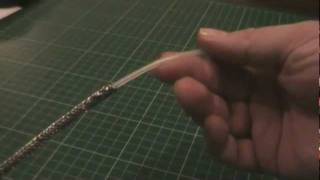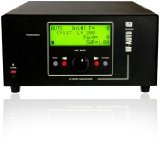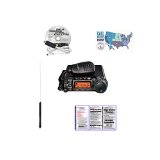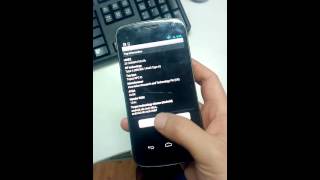Here I take an old tv antenna and make a 6m High Frequency radio antenne.
Video Rating: 4 / 5

Constructing a cheap and simple Bazooka antenna for the CB Band in this video.
Made from coax, this is an ideal antenna for portable use or as an emergency antenna – calcs and design thanks to here: http://www.hamuniverse.com/vertbazooka.html






Well done for having a go at home construction, but here’s some info you
may find of use: The velocity factor is incorrect, RG58 only has a velocity
factor of 0.66 when it is used as coax, the moment you strip the screen and
outer sheath away then the VF changes, this is why you had to make your
antenna longer.
That’ll be great – anything that’s simple, robust, lightweight, quick to
deploy and works quite well is certainly of interest. The Bazooka fits the
bill well, but better still if folding the braid over can be eliminated.
Cheers.
I have been playing with this type of antenna, if I get time next week I’ll
make a short video detailing my findings and post it as a reply if that’s
ok I enjoy your videos by the way, experimenting and portable is where the
fun is 😉
Hello Gary How did you arrive at a freq. of 27.5 mhz? Thank you
Hi Gary…. What is the size of the heat shrink? Going to make one of these
to hang in a tree at bottom of the garden….
I actually got a link for the Bazooka design from a post of yours on a
forum – so I guess you’ve experimented more since then. I’ll try cutting
the screen off on the next one – where would the choke be best positioned,
in the same place at it would be on the sleeved design? Cheers.
Hi gary enjoyed your video,but wandered if you ever heard of a double
bazooka .Basically it is a folded dipole more gain than center fed dipole.
just tie ends of coax together and feed it in the middle insulating braid
to braid center to center.thanks gary
Mite make one them i need antenna sometime for me classic Havard H-407 home
base rig 🙂
Nice old rig the H-407. Perhaps try the T2LT antenna I’ve recently started
using – very much like the Bazooka, but no braid to fold over. T2LT video
added to the channel – both antennas work well for what they are. Cheers.
Looks like some coax cables are easier than others to work with, looks like
I got lucky. You could always make a centre-fed dipole out of the coax
instead.
A little better lighting would help out a bit.Excellent video though.
Secondly it isn’t necessary to pull the screen back over the coax, the
screen itself will carry differential mode current, that is why coax is
described as unbalanced line, if you cut the exposed screen off, you’ll
find the antenna works just as well, the screen will carry normal return
current on the inner surface and antenna current on the outside of the
screen. When you’re done choke it off, then add shrink sleeving where
you’ve removed the outer, sorted 😉
For an antenna made from coax, it is very good. Cheers.
Glad you like the videos – hoping to do a few activations in the snow over
the winter. Cheers.
thanks for the video
hi friend good afternoon if possible would like me to pass this scheme
bazooka antenna I am looking long time for one work station in qrp 27mhz if
possible translate pro Brazil this scheme thank friend
congratulations by video
Strong 73 to you and family
fernando 3fat016 from Brazil
THESE ANTENNAS WORK EXTREMELY WELL! Especially if you make them from
quality materials, execute good workmanship in your soldering and connector
installation, and if you’re willing to experiment a bit at the beginning to
ensure you have it “optimized” for the particular location & situation you
are in.
For example, I attached a set of pulleys and rope on the ends of my dipole
and strung the entire assembly between two 50′ push-up poles so that I
could easily adjust the distance from the ground to the antenna while
observing my SWR meter.
I learned that the SWR might change a bit even when the antenna was at the
same exact height, not only when I changed frequencies, but also apparently
due to changes in the moisture in the ground depending on if it had just
rained a lot or if the ground was dry. I could tweak the SWR a bit by
raising or lowering the antenna a few feet.
I was especially pleased to learn that I could affect the “take off
direction” of my transmitted signal as well as my received signals, by
raising or lowering only one end. Sometimes I achieved good results by
allowing the center to be the highest point, and lowering the ends….the
old “Inverted V” configuration. And sometimes I achieved by desired
coverage distance and pattern by doing the very opposite…the “V”
configuration.
I really did well with this antenna and keep several coiled up and ready to
go in my emergency communications vehicle; one antenna for each of my most
important bands. Some antennas were resonant on several bands and required
very little adjustment if at all during band changes..
And IF your station is set up to where you can use “ladder line” instead
of, or in addition to a coaxial feed, there are many people who achieve
truly phenomenal results that way. And in any situation, IF you have a
good, easily accessible EARTH ground that you can attach the chassis ground
to, that sometimes makes ALL the difference.
When making this, do try to use heat shrink on all solder connections and
all locations on your coax where it attaches to a PL-259 or whatever you
use…neatness DOES count, AND helps ensure the dependability and longevity
of your project!
THANKS for posting this tutorial on how to make these antennas. I have used
them on 450 mhz on down to below 160 meters, and I can say not only do they
work and work well, but this is attested to by the fact that many of the
world’s militaries, search & rescue organizations, scientific expeditions,
etc, have used these antennas for many years, and continue to do so to this
day.
Thanks for sharing this with us all, its very much appreciated that you
take the time to show this stuff and give us all ideas! I’ll have a go at
making one of these very soon. Will try get on the North East Net soon too!
Cheers and beers good sir.
Hi there, what dimentions would you use for 2 mts, I am what they call Old
School, so would the top be 19-20 inches and the coax down the same, does
the balun just act as an rf choke, does it matter if its there or not?,
readings minus velocity factor of coax….Fred g4vvq
Does anybody know how to calculate the length of a radial for CB etc?
Hi…many thanks for the link for ground plane Calcs! Much appreciated :-)
Love bein cheap..that’s MY way.
Rivet…Rivet…Rivet….way to go toad! Rivet…Rivet…Rivet
very nice toad, thanks for sharing
COOL!
Thanks Red!
Yes it is. However it does on many occasions, “bounce” (sporadic E
propagation) like HF. So long distance communications happen.
THERE ya go..be listening for ya this summer bro.
Super cool way to reuse stuff. Great job my friend. Glad it works well.
Nice job toad !
Brilliant Toad!
Agreed. I want to know as MUCH as I can..
I understand toad. I thought I was being funny..you must be beat from on
the road! Hope ya feel better my friend!
Thanks J.
Good Job! My congrats. Best regards
73 de VA6POP
muito bom
I just passed my Tech License and am now studying for the General. My main
interest is 70cm/2M/6M/10M bands. I am amazed at how simple some antennas
are to make. Very nice video. I have a lot to learn.
Aha i undertand 6 bucks for the 6m Band. 😎
Where is the UNBAL for the Asymetric CoaxCable to the Symtric Antenna?